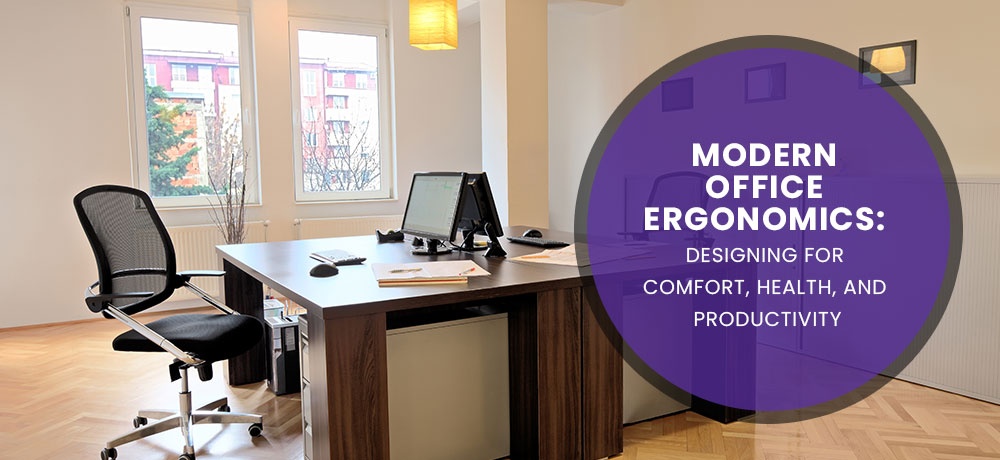Modern Office Ergonomics: Designing for Comfort, Health, and Productivity

In today's fast-paced work environment, employee well-being is a top priority for businesses seeking to enhance productivity and retain a talented workforce. Modern office ergonomics has emerged as a crucial aspect of office design, focusing on creating workspaces that prioritize comfort, health, and productivity. By understanding the principles of ergonomic design and implementing them effectively, businesses can create an environment where employees can thrive and excel. In this blog post, we will explore the importance of modern office ergonomics and how it contributes to comfort, health, and overall productivity.
- The Significance of Ergonomics in the Workplace: Ergonomics is the science of designing the workplace to fit the capabilities and needs of the employees. It involves optimizing the interaction between people, their work tasks, and the environment. A well-designed ergonomic workspace can prevent injuries, reduce discomfort, and enhance overall well-being, leading to increased job satisfaction and productivity.
- Ergonomic Furniture and Accessories: Central to modern office ergonomics is the selection of ergonomic furniture and accessories. Adjustable chairs with lumbar support, adjustable desks, and monitor stands allow employees to customize their workstations to their body dimensions and preferences. Ergonomic accessories such as keyboard trays, footrests, and wrist supports further contribute to a comfortable and health-conscious workspace.
- Proper Posture and Alignment: Maintaining proper posture is essential to prevent musculoskeletal disorders and promote long-term health. Ergonomically designed furniture encourages employees to sit, stand, and type in positions that support the natural alignment of the body. Adjustable chairs with proper lumbar support and desks with varying heights enable employees to switch between sitting and standing, reducing the risk of strain and fatigue.
- Natural Movement and Mobility: Sedentary work habits can lead to various health issues. Modern office ergonomics encourages natural movement and mobility throughout the day. Sit-stand desks, balance ball chairs, and active seating options promote gentle muscle engagement and encourage employees to shift their posture, enhancing blood circulation and reducing the negative impact of prolonged sitting.
- Lighting and Display Ergonomics: Proper lighting and display ergonomics are essential for reducing eye strain and enhancing focus. Adequate ambient lighting, adjustable task lighting, and proper screen positioning contribute to a comfortable visual environment. Blue light filters and anti-glare screens can also help reduce eye fatigue caused by prolonged computer use.
- Noise Reduction and Acoustics: Office acoustics are an often-overlooked aspect of ergonomics. Excessive noise levels can lead to stress and reduced concentration. Ergonomically designed spaces incorporate acoustic elements such as sound-absorbing panels, carpets, and partitions to create a quieter and more focused work environment.
- Personalization and Employee Well-being: Modern office ergonomics also acknowledges the importance of personalization. Allowing employees to personalize their workstations with ergonomic accessories that suit their needs fosters a sense of ownership and well-being. Adjustable furniture and accessories empower employees to create a workspace that aligns with their comfort and health requirements.
- The Impact on Productivity and Job Satisfaction: A workspace that prioritizes modern office ergonomics directly impacts productivity and job satisfaction. When employees are comfortable, physically supported, and free from discomfort, they can focus more on their tasks, leading to increased efficiency and higher work quality. Moreover, a company's investment in employee well-being through ergonomic design demonstrates a commitment to their health and can lead to greater job satisfaction and loyalty.
Conclusion:
Modern office ergonomics is not just a trend; it's a strategic approach that recognizes the vital link between employee comfort, health, and productivity. By designing workspaces that prioritize proper posture, movement, lighting, acoustics, and personalization, businesses can create an environment where employees are empowered to perform at their best. Investing in modern office ergonomics is an investment in the well-being of employees, which in turn contributes to a more motivated, engaged, and productive workforce, ultimately leading to the overall success of the organization.